Globalisation of Starbucks: Drivers, Strategies, and Challenges
VerifiedAdded on 2020/10/22
|9
|2608
|66
Report
AI Summary
This report provides a comprehensive analysis of Starbucks' globalization strategy, focusing on its expansion into the South African market. It begins by examining the key drivers of globalization, such as technological advancements, international trade, and communication, and how these factors influence Starbucks' global expansion. The report then delves into the company's strategies, particularly its use of franchising as a market entry strategy, and discusses the benefits and drawbacks of this approach. The report further explores Starbucks' efforts to maintain growth in South Africa, considering the economic pressures and competitive landscape. Finally, it identifies the opportunities and challenges Starbucks faces in the South African market, including rising costs, mobile ordering, and expansion in China, providing a detailed overview of the company's strategic considerations and future prospects within the context of globalization.
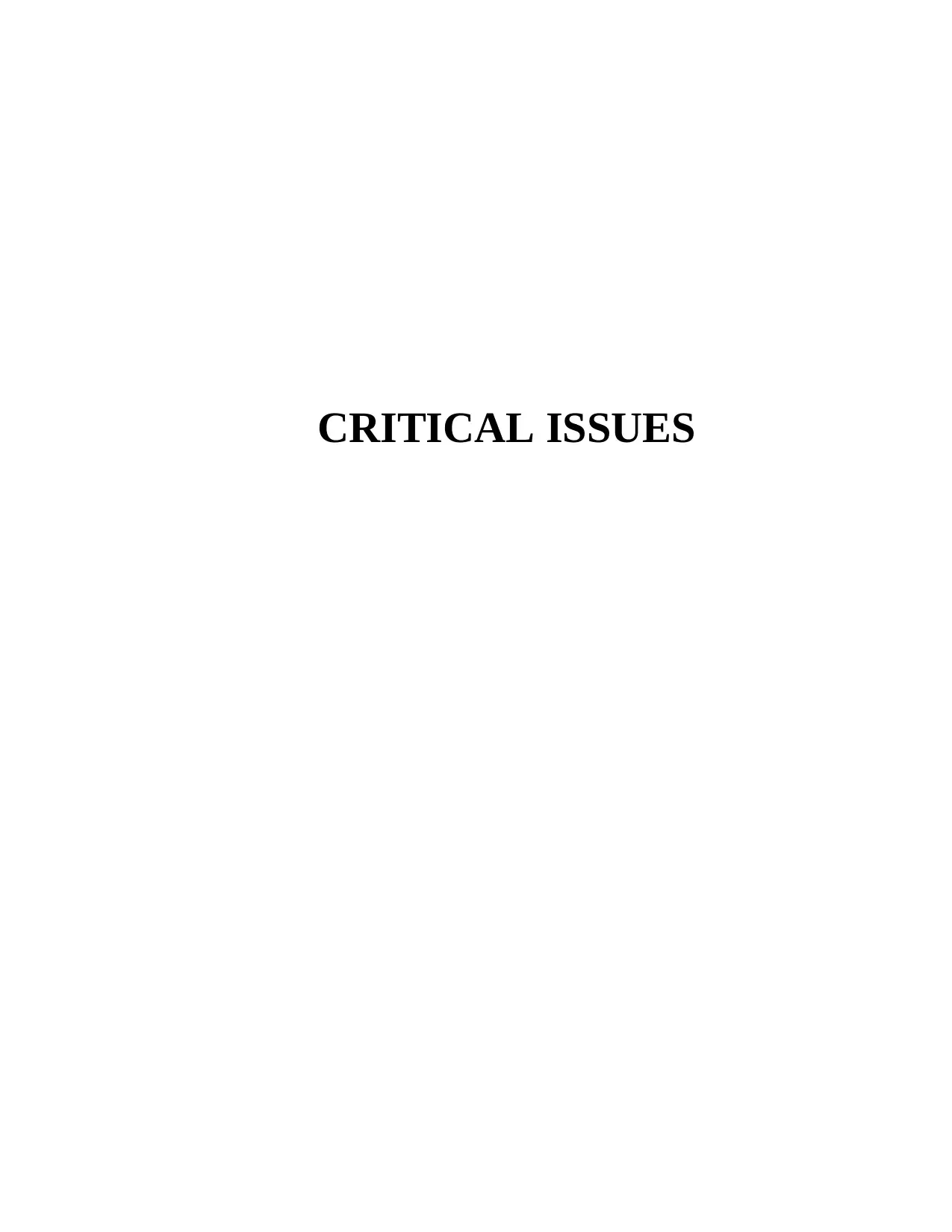
CRITICAL ISSUES
Paraphrase This Document
Need a fresh take? Get an instant paraphrase of this document with our AI Paraphraser
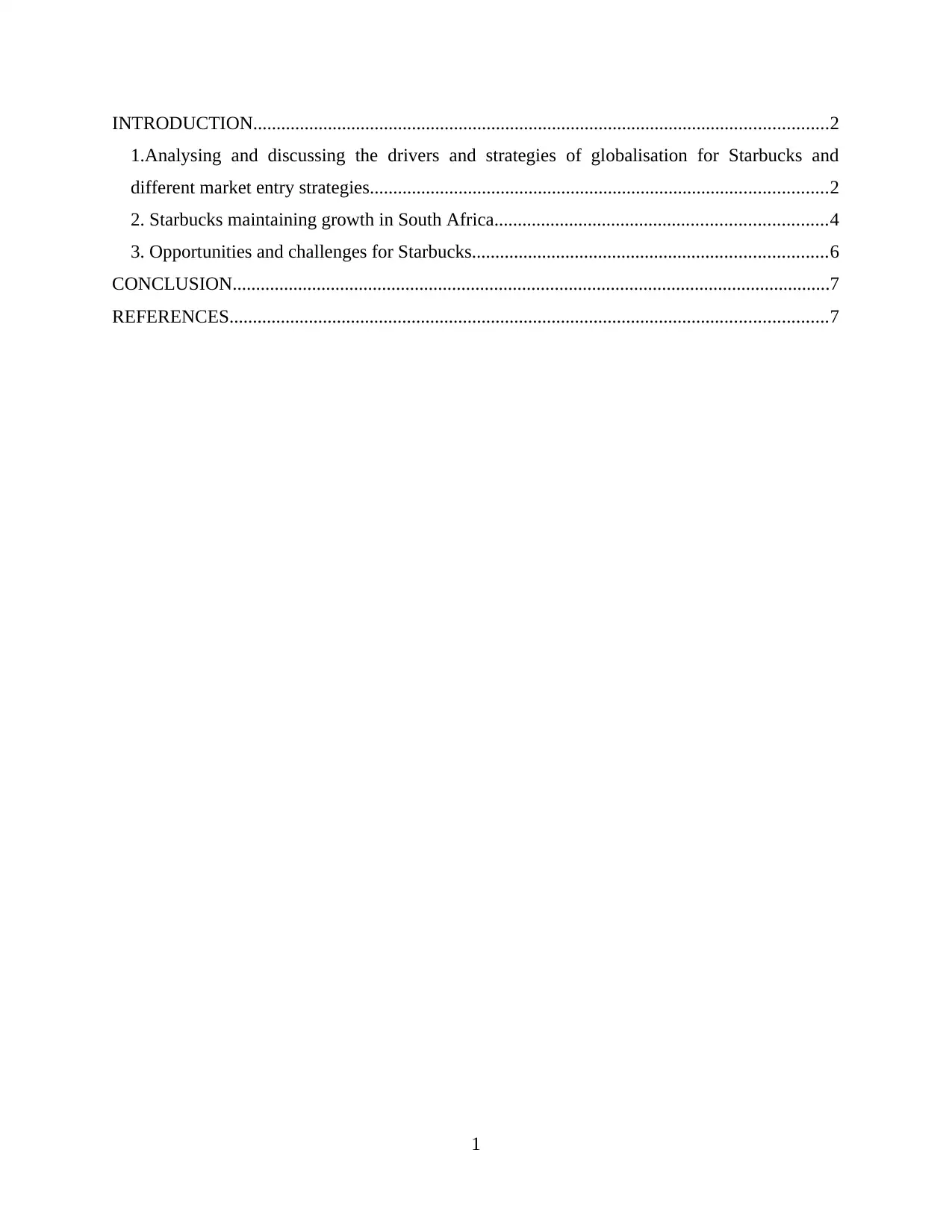
INTRODUCTION...........................................................................................................................2
1.Analysing and discussing the drivers and strategies of globalisation for Starbucks and
different market entry strategies..................................................................................................2
2. Starbucks maintaining growth in South Africa.......................................................................4
3. Opportunities and challenges for Starbucks............................................................................6
CONCLUSION................................................................................................................................7
REFERENCES................................................................................................................................7
1
1.Analysing and discussing the drivers and strategies of globalisation for Starbucks and
different market entry strategies..................................................................................................2
2. Starbucks maintaining growth in South Africa.......................................................................4
3. Opportunities and challenges for Starbucks............................................................................6
CONCLUSION................................................................................................................................7
REFERENCES................................................................................................................................7
1
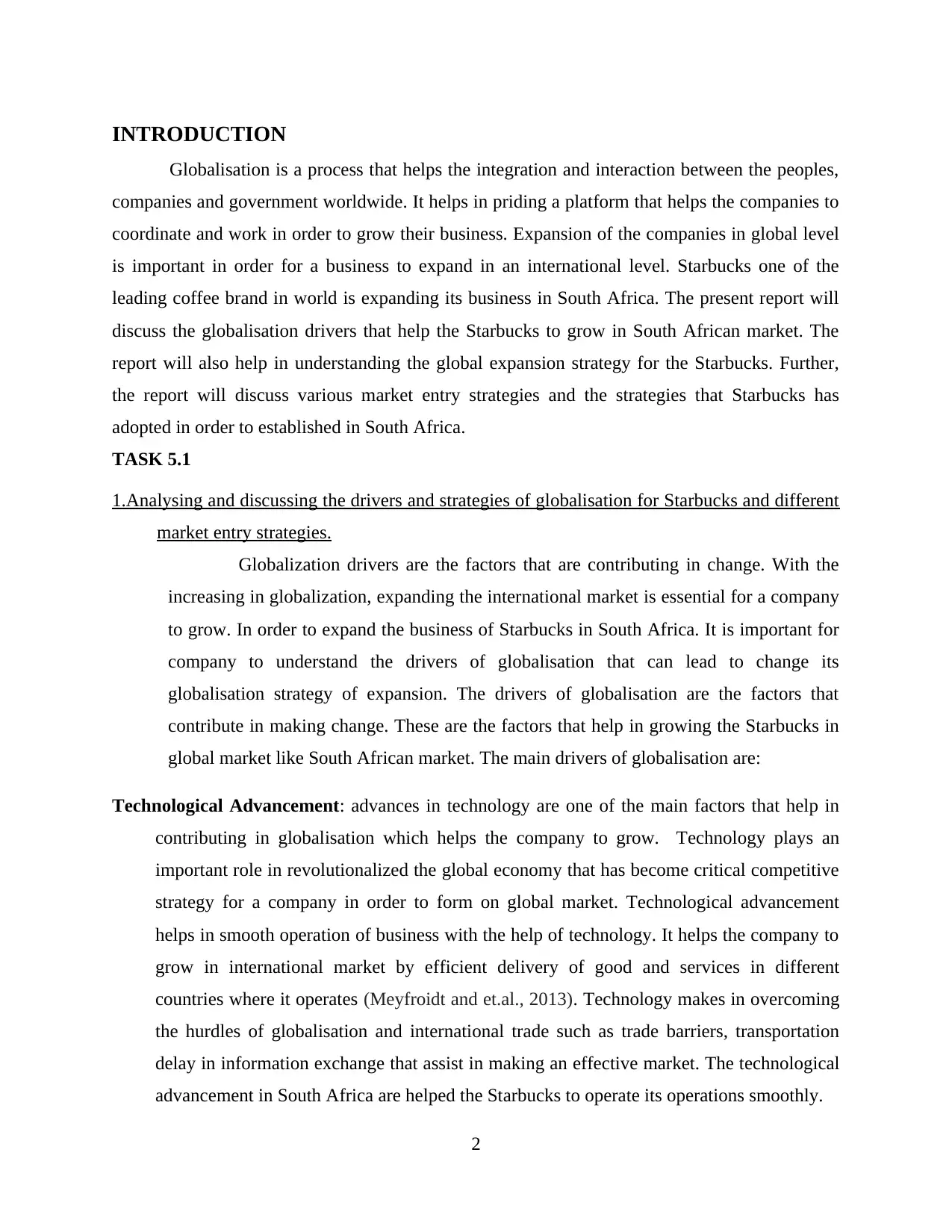
INTRODUCTION
Globalisation is a process that helps the integration and interaction between the peoples,
companies and government worldwide. It helps in priding a platform that helps the companies to
coordinate and work in order to grow their business. Expansion of the companies in global level
is important in order for a business to expand in an international level. Starbucks one of the
leading coffee brand in world is expanding its business in South Africa. The present report will
discuss the globalisation drivers that help the Starbucks to grow in South African market. The
report will also help in understanding the global expansion strategy for the Starbucks. Further,
the report will discuss various market entry strategies and the strategies that Starbucks has
adopted in order to established in South Africa.
TASK 5.1
1.Analysing and discussing the drivers and strategies of globalisation for Starbucks and different
market entry strategies.
Globalization drivers are the factors that are contributing in change. With the
increasing in globalization, expanding the international market is essential for a company
to grow. In order to expand the business of Starbucks in South Africa. It is important for
company to understand the drivers of globalisation that can lead to change its
globalisation strategy of expansion. The drivers of globalisation are the factors that
contribute in making change. These are the factors that help in growing the Starbucks in
global market like South African market. The main drivers of globalisation are:
Technological Advancement: advances in technology are one of the main factors that help in
contributing in globalisation which helps the company to grow. Technology plays an
important role in revolutionalized the global economy that has become critical competitive
strategy for a company in order to form on global market. Technological advancement
helps in smooth operation of business with the help of technology. It helps the company to
grow in international market by efficient delivery of good and services in different
countries where it operates (Meyfroidt and et.al., 2013). Technology makes in overcoming
the hurdles of globalisation and international trade such as trade barriers, transportation
delay in information exchange that assist in making an effective market. The technological
advancement in South Africa are helped the Starbucks to operate its operations smoothly.
2
Globalisation is a process that helps the integration and interaction between the peoples,
companies and government worldwide. It helps in priding a platform that helps the companies to
coordinate and work in order to grow their business. Expansion of the companies in global level
is important in order for a business to expand in an international level. Starbucks one of the
leading coffee brand in world is expanding its business in South Africa. The present report will
discuss the globalisation drivers that help the Starbucks to grow in South African market. The
report will also help in understanding the global expansion strategy for the Starbucks. Further,
the report will discuss various market entry strategies and the strategies that Starbucks has
adopted in order to established in South Africa.
TASK 5.1
1.Analysing and discussing the drivers and strategies of globalisation for Starbucks and different
market entry strategies.
Globalization drivers are the factors that are contributing in change. With the
increasing in globalization, expanding the international market is essential for a company
to grow. In order to expand the business of Starbucks in South Africa. It is important for
company to understand the drivers of globalisation that can lead to change its
globalisation strategy of expansion. The drivers of globalisation are the factors that
contribute in making change. These are the factors that help in growing the Starbucks in
global market like South African market. The main drivers of globalisation are:
Technological Advancement: advances in technology are one of the main factors that help in
contributing in globalisation which helps the company to grow. Technology plays an
important role in revolutionalized the global economy that has become critical competitive
strategy for a company in order to form on global market. Technological advancement
helps in smooth operation of business with the help of technology. It helps the company to
grow in international market by efficient delivery of good and services in different
countries where it operates (Meyfroidt and et.al., 2013). Technology makes in overcoming
the hurdles of globalisation and international trade such as trade barriers, transportation
delay in information exchange that assist in making an effective market. The technological
advancement in South Africa are helped the Starbucks to operate its operations smoothly.
2
⊘ This is a preview!⊘
Do you want full access?
Subscribe today to unlock all pages.

Trusted by 1+ million students worldwide
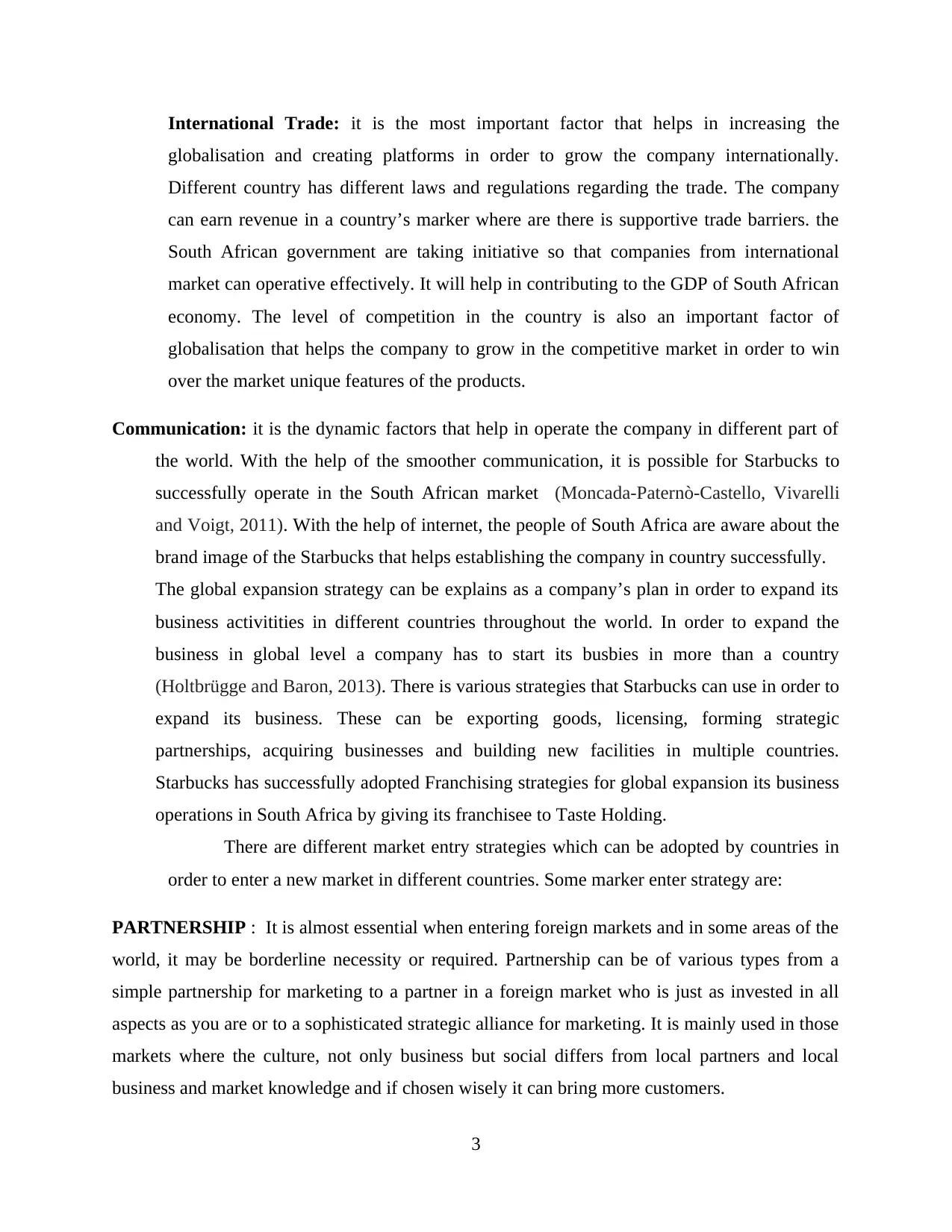
International Trade: it is the most important factor that helps in increasing the
globalisation and creating platforms in order to grow the company internationally.
Different country has different laws and regulations regarding the trade. The company
can earn revenue in a country’s marker where are there is supportive trade barriers. the
South African government are taking initiative so that companies from international
market can operative effectively. It will help in contributing to the GDP of South African
economy. The level of competition in the country is also an important factor of
globalisation that helps the company to grow in the competitive market in order to win
over the market unique features of the products.
Communication: it is the dynamic factors that help in operate the company in different part of
the world. With the help of the smoother communication, it is possible for Starbucks to
successfully operate in the South African market (Moncada-Paternò-Castello, Vivarelli
and Voigt, 2011). With the help of internet, the people of South Africa are aware about the
brand image of the Starbucks that helps establishing the company in country successfully.
The global expansion strategy can be explains as a company’s plan in order to expand its
business activitities in different countries throughout the world. In order to expand the
business in global level a company has to start its busbies in more than a country
(Holtbrügge and Baron, 2013). There is various strategies that Starbucks can use in order to
expand its business. These can be exporting goods, licensing, forming strategic
partnerships, acquiring businesses and building new facilities in multiple countries.
Starbucks has successfully adopted Franchising strategies for global expansion its business
operations in South Africa by giving its franchisee to Taste Holding.
There are different market entry strategies which can be adopted by countries in
order to enter a new market in different countries. Some marker enter strategy are:
PARTNERSHIP : It is almost essential when entering foreign markets and in some areas of the
world, it may be borderline necessity or required. Partnership can be of various types from a
simple partnership for marketing to a partner in a foreign market who is just as invested in all
aspects as you are or to a sophisticated strategic alliance for marketing. It is mainly used in those
markets where the culture, not only business but social differs from local partners and local
business and market knowledge and if chosen wisely it can bring more customers.
3
globalisation and creating platforms in order to grow the company internationally.
Different country has different laws and regulations regarding the trade. The company
can earn revenue in a country’s marker where are there is supportive trade barriers. the
South African government are taking initiative so that companies from international
market can operative effectively. It will help in contributing to the GDP of South African
economy. The level of competition in the country is also an important factor of
globalisation that helps the company to grow in the competitive market in order to win
over the market unique features of the products.
Communication: it is the dynamic factors that help in operate the company in different part of
the world. With the help of the smoother communication, it is possible for Starbucks to
successfully operate in the South African market (Moncada-Paternò-Castello, Vivarelli
and Voigt, 2011). With the help of internet, the people of South Africa are aware about the
brand image of the Starbucks that helps establishing the company in country successfully.
The global expansion strategy can be explains as a company’s plan in order to expand its
business activitities in different countries throughout the world. In order to expand the
business in global level a company has to start its busbies in more than a country
(Holtbrügge and Baron, 2013). There is various strategies that Starbucks can use in order to
expand its business. These can be exporting goods, licensing, forming strategic
partnerships, acquiring businesses and building new facilities in multiple countries.
Starbucks has successfully adopted Franchising strategies for global expansion its business
operations in South Africa by giving its franchisee to Taste Holding.
There are different market entry strategies which can be adopted by countries in
order to enter a new market in different countries. Some marker enter strategy are:
PARTNERSHIP : It is almost essential when entering foreign markets and in some areas of the
world, it may be borderline necessity or required. Partnership can be of various types from a
simple partnership for marketing to a partner in a foreign market who is just as invested in all
aspects as you are or to a sophisticated strategic alliance for marketing. It is mainly used in those
markets where the culture, not only business but social differs from local partners and local
business and market knowledge and if chosen wisely it can bring more customers.
3
Paraphrase This Document
Need a fresh take? Get an instant paraphrase of this document with our AI Paraphraser
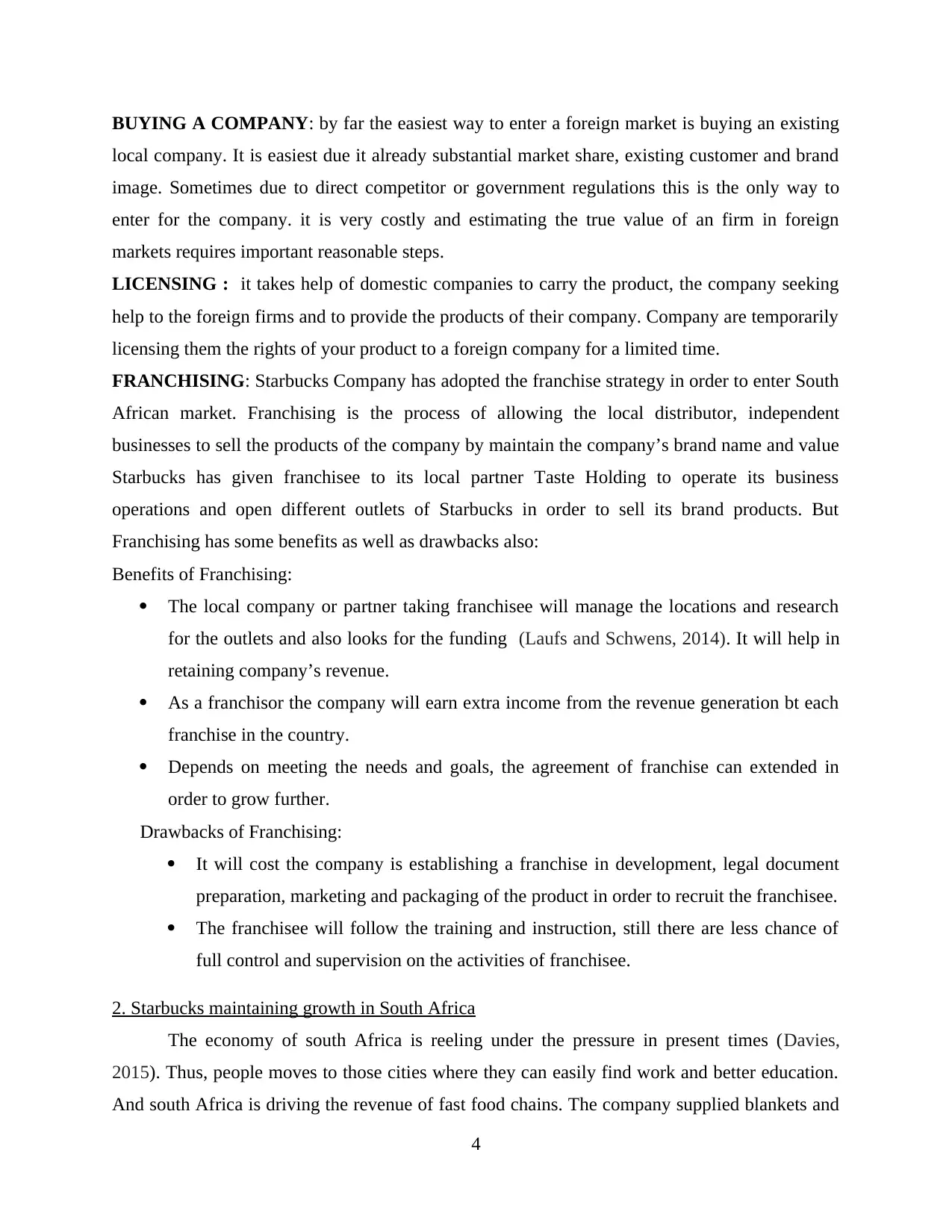
BUYING A COMPANY: by far the easiest way to enter a foreign market is buying an existing
local company. It is easiest due it already substantial market share, existing customer and brand
image. Sometimes due to direct competitor or government regulations this is the only way to
enter for the company. it is very costly and estimating the true value of an firm in foreign
markets requires important reasonable steps.
LICENSING : it takes help of domestic companies to carry the product, the company seeking
help to the foreign firms and to provide the products of their company. Company are temporarily
licensing them the rights of your product to a foreign company for a limited time.
FRANCHISING: Starbucks Company has adopted the franchise strategy in order to enter South
African market. Franchising is the process of allowing the local distributor, independent
businesses to sell the products of the company by maintain the company’s brand name and value
Starbucks has given franchisee to its local partner Taste Holding to operate its business
operations and open different outlets of Starbucks in order to sell its brand products. But
Franchising has some benefits as well as drawbacks also:
Benefits of Franchising:
The local company or partner taking franchisee will manage the locations and research
for the outlets and also looks for the funding (Laufs and Schwens, 2014). It will help in
retaining company’s revenue.
As a franchisor the company will earn extra income from the revenue generation bt each
franchise in the country.
Depends on meeting the needs and goals, the agreement of franchise can extended in
order to grow further.
Drawbacks of Franchising:
It will cost the company is establishing a franchise in development, legal document
preparation, marketing and packaging of the product in order to recruit the franchisee.
The franchisee will follow the training and instruction, still there are less chance of
full control and supervision on the activities of franchisee.
2. Starbucks maintaining growth in South Africa
The economy of south Africa is reeling under the pressure in present times (Davies,
2015). Thus, people moves to those cities where they can easily find work and better education.
And south Africa is driving the revenue of fast food chains. The company supplied blankets and
4
local company. It is easiest due it already substantial market share, existing customer and brand
image. Sometimes due to direct competitor or government regulations this is the only way to
enter for the company. it is very costly and estimating the true value of an firm in foreign
markets requires important reasonable steps.
LICENSING : it takes help of domestic companies to carry the product, the company seeking
help to the foreign firms and to provide the products of their company. Company are temporarily
licensing them the rights of your product to a foreign company for a limited time.
FRANCHISING: Starbucks Company has adopted the franchise strategy in order to enter South
African market. Franchising is the process of allowing the local distributor, independent
businesses to sell the products of the company by maintain the company’s brand name and value
Starbucks has given franchisee to its local partner Taste Holding to operate its business
operations and open different outlets of Starbucks in order to sell its brand products. But
Franchising has some benefits as well as drawbacks also:
Benefits of Franchising:
The local company or partner taking franchisee will manage the locations and research
for the outlets and also looks for the funding (Laufs and Schwens, 2014). It will help in
retaining company’s revenue.
As a franchisor the company will earn extra income from the revenue generation bt each
franchise in the country.
Depends on meeting the needs and goals, the agreement of franchise can extended in
order to grow further.
Drawbacks of Franchising:
It will cost the company is establishing a franchise in development, legal document
preparation, marketing and packaging of the product in order to recruit the franchisee.
The franchisee will follow the training and instruction, still there are less chance of
full control and supervision on the activities of franchisee.
2. Starbucks maintaining growth in South Africa
The economy of south Africa is reeling under the pressure in present times (Davies,
2015). Thus, people moves to those cities where they can easily find work and better education.
And south Africa is driving the revenue of fast food chains. The company supplied blankets and
4
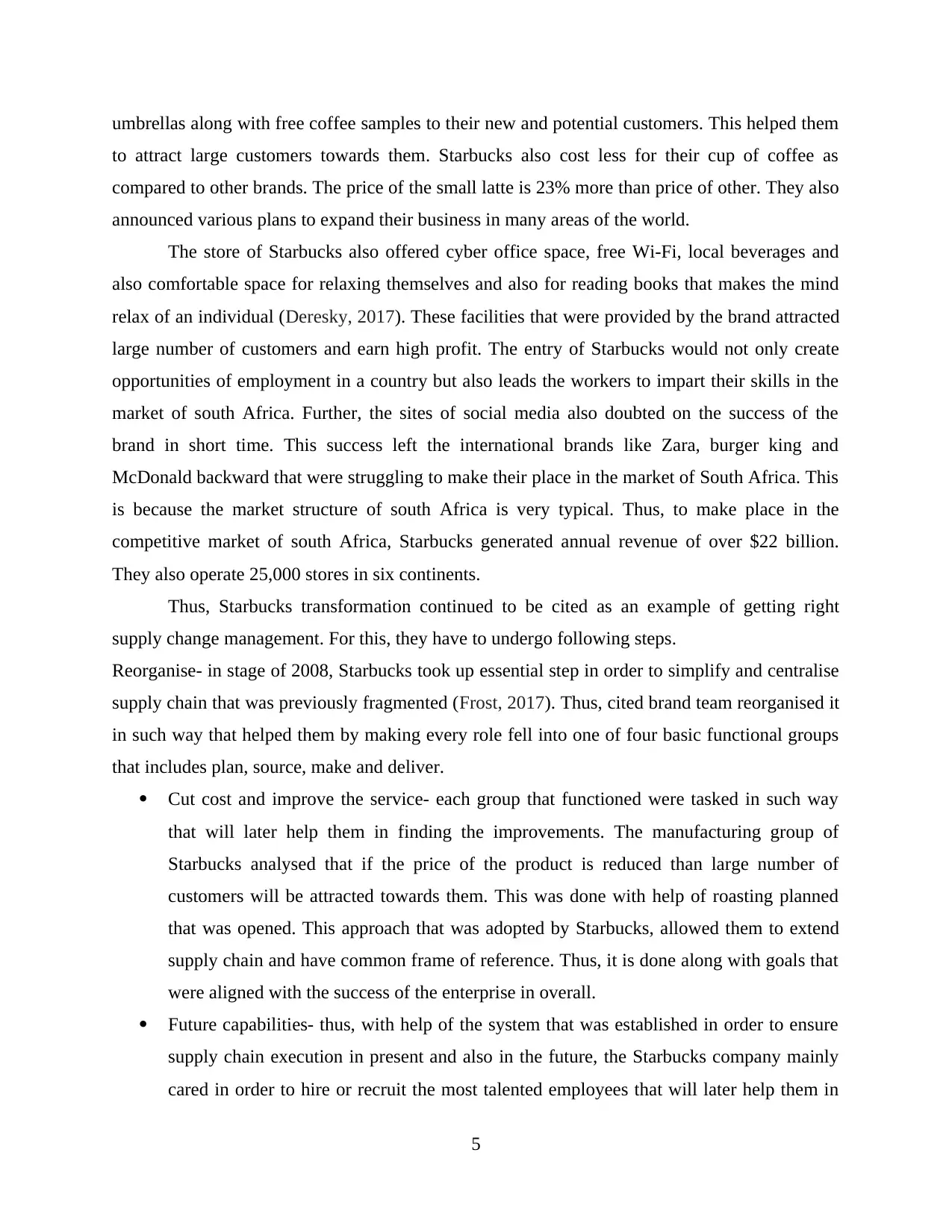
umbrellas along with free coffee samples to their new and potential customers. This helped them
to attract large customers towards them. Starbucks also cost less for their cup of coffee as
compared to other brands. The price of the small latte is 23% more than price of other. They also
announced various plans to expand their business in many areas of the world.
The store of Starbucks also offered cyber office space, free Wi-Fi, local beverages and
also comfortable space for relaxing themselves and also for reading books that makes the mind
relax of an individual (Deresky, 2017). These facilities that were provided by the brand attracted
large number of customers and earn high profit. The entry of Starbucks would not only create
opportunities of employment in a country but also leads the workers to impart their skills in the
market of south Africa. Further, the sites of social media also doubted on the success of the
brand in short time. This success left the international brands like Zara, burger king and
McDonald backward that were struggling to make their place in the market of South Africa. This
is because the market structure of south Africa is very typical. Thus, to make place in the
competitive market of south Africa, Starbucks generated annual revenue of over $22 billion.
They also operate 25,000 stores in six continents.
Thus, Starbucks transformation continued to be cited as an example of getting right
supply change management. For this, they have to undergo following steps.
Reorganise- in stage of 2008, Starbucks took up essential step in order to simplify and centralise
supply chain that was previously fragmented (Frost, 2017). Thus, cited brand team reorganised it
in such way that helped them by making every role fell into one of four basic functional groups
that includes plan, source, make and deliver.
Cut cost and improve the service- each group that functioned were tasked in such way
that will later help them in finding the improvements. The manufacturing group of
Starbucks analysed that if the price of the product is reduced than large number of
customers will be attracted towards them. This was done with help of roasting planned
that was opened. This approach that was adopted by Starbucks, allowed them to extend
supply chain and have common frame of reference. Thus, it is done along with goals that
were aligned with the success of the enterprise in overall.
Future capabilities- thus, with help of the system that was established in order to ensure
supply chain execution in present and also in the future, the Starbucks company mainly
cared in order to hire or recruit the most talented employees that will later help them in
5
to attract large customers towards them. Starbucks also cost less for their cup of coffee as
compared to other brands. The price of the small latte is 23% more than price of other. They also
announced various plans to expand their business in many areas of the world.
The store of Starbucks also offered cyber office space, free Wi-Fi, local beverages and
also comfortable space for relaxing themselves and also for reading books that makes the mind
relax of an individual (Deresky, 2017). These facilities that were provided by the brand attracted
large number of customers and earn high profit. The entry of Starbucks would not only create
opportunities of employment in a country but also leads the workers to impart their skills in the
market of south Africa. Further, the sites of social media also doubted on the success of the
brand in short time. This success left the international brands like Zara, burger king and
McDonald backward that were struggling to make their place in the market of South Africa. This
is because the market structure of south Africa is very typical. Thus, to make place in the
competitive market of south Africa, Starbucks generated annual revenue of over $22 billion.
They also operate 25,000 stores in six continents.
Thus, Starbucks transformation continued to be cited as an example of getting right
supply change management. For this, they have to undergo following steps.
Reorganise- in stage of 2008, Starbucks took up essential step in order to simplify and centralise
supply chain that was previously fragmented (Frost, 2017). Thus, cited brand team reorganised it
in such way that helped them by making every role fell into one of four basic functional groups
that includes plan, source, make and deliver.
Cut cost and improve the service- each group that functioned were tasked in such way
that will later help them in finding the improvements. The manufacturing group of
Starbucks analysed that if the price of the product is reduced than large number of
customers will be attracted towards them. This was done with help of roasting planned
that was opened. This approach that was adopted by Starbucks, allowed them to extend
supply chain and have common frame of reference. Thus, it is done along with goals that
were aligned with the success of the enterprise in overall.
Future capabilities- thus, with help of the system that was established in order to ensure
supply chain execution in present and also in the future, the Starbucks company mainly
cared in order to hire or recruit the most talented employees that will later help them in
5
⊘ This is a preview!⊘
Do you want full access?
Subscribe today to unlock all pages.

Trusted by 1+ million students worldwide
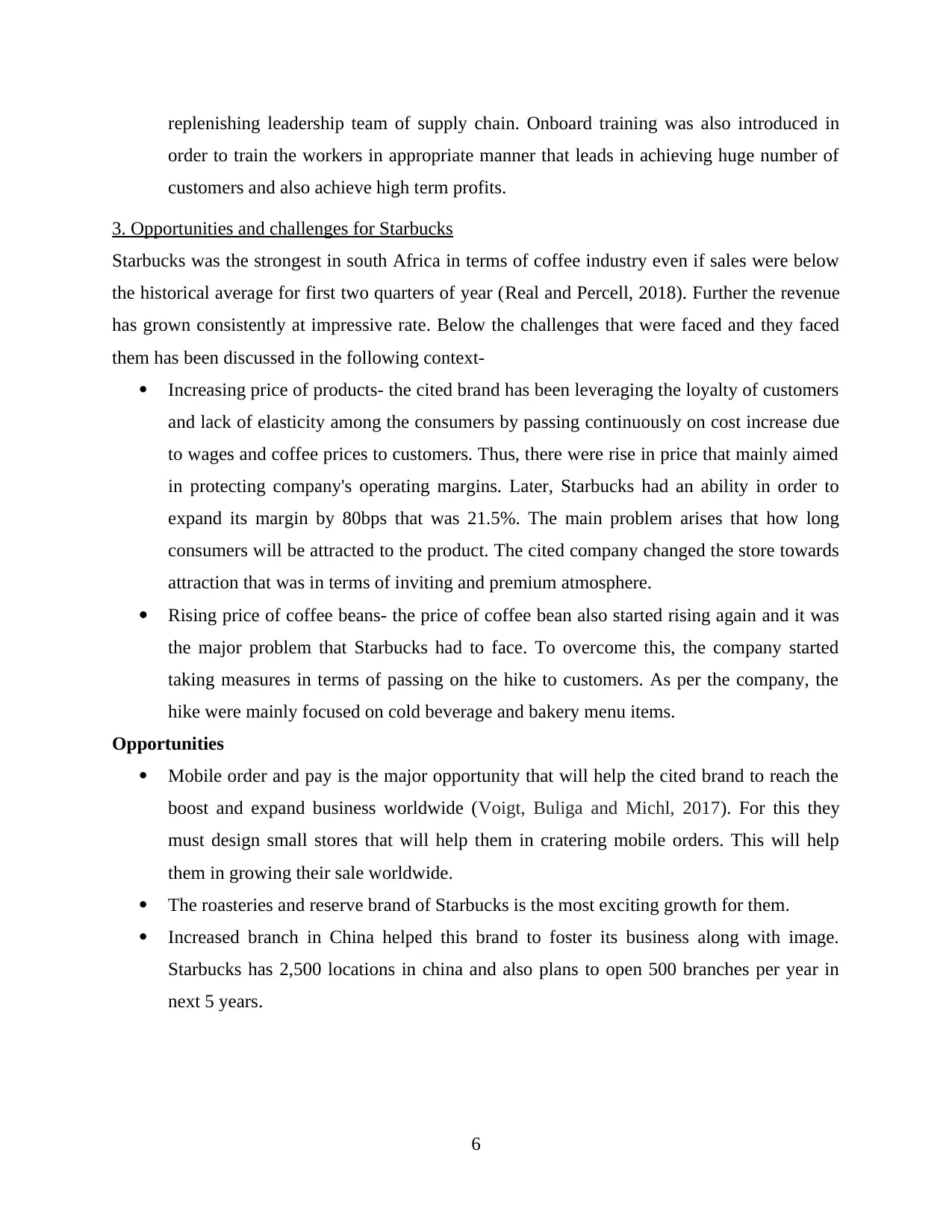
replenishing leadership team of supply chain. Onboard training was also introduced in
order to train the workers in appropriate manner that leads in achieving huge number of
customers and also achieve high term profits.
3. Opportunities and challenges for Starbucks
Starbucks was the strongest in south Africa in terms of coffee industry even if sales were below
the historical average for first two quarters of year (Real and Percell, 2018). Further the revenue
has grown consistently at impressive rate. Below the challenges that were faced and they faced
them has been discussed in the following context-
Increasing price of products- the cited brand has been leveraging the loyalty of customers
and lack of elasticity among the consumers by passing continuously on cost increase due
to wages and coffee prices to customers. Thus, there were rise in price that mainly aimed
in protecting company's operating margins. Later, Starbucks had an ability in order to
expand its margin by 80bps that was 21.5%. The main problem arises that how long
consumers will be attracted to the product. The cited company changed the store towards
attraction that was in terms of inviting and premium atmosphere.
Rising price of coffee beans- the price of coffee bean also started rising again and it was
the major problem that Starbucks had to face. To overcome this, the company started
taking measures in terms of passing on the hike to customers. As per the company, the
hike were mainly focused on cold beverage and bakery menu items.
Opportunities
Mobile order and pay is the major opportunity that will help the cited brand to reach the
boost and expand business worldwide (Voigt, Buliga and Michl, 2017). For this they
must design small stores that will help them in cratering mobile orders. This will help
them in growing their sale worldwide.
The roasteries and reserve brand of Starbucks is the most exciting growth for them.
Increased branch in China helped this brand to foster its business along with image.
Starbucks has 2,500 locations in china and also plans to open 500 branches per year in
next 5 years.
6
order to train the workers in appropriate manner that leads in achieving huge number of
customers and also achieve high term profits.
3. Opportunities and challenges for Starbucks
Starbucks was the strongest in south Africa in terms of coffee industry even if sales were below
the historical average for first two quarters of year (Real and Percell, 2018). Further the revenue
has grown consistently at impressive rate. Below the challenges that were faced and they faced
them has been discussed in the following context-
Increasing price of products- the cited brand has been leveraging the loyalty of customers
and lack of elasticity among the consumers by passing continuously on cost increase due
to wages and coffee prices to customers. Thus, there were rise in price that mainly aimed
in protecting company's operating margins. Later, Starbucks had an ability in order to
expand its margin by 80bps that was 21.5%. The main problem arises that how long
consumers will be attracted to the product. The cited company changed the store towards
attraction that was in terms of inviting and premium atmosphere.
Rising price of coffee beans- the price of coffee bean also started rising again and it was
the major problem that Starbucks had to face. To overcome this, the company started
taking measures in terms of passing on the hike to customers. As per the company, the
hike were mainly focused on cold beverage and bakery menu items.
Opportunities
Mobile order and pay is the major opportunity that will help the cited brand to reach the
boost and expand business worldwide (Voigt, Buliga and Michl, 2017). For this they
must design small stores that will help them in cratering mobile orders. This will help
them in growing their sale worldwide.
The roasteries and reserve brand of Starbucks is the most exciting growth for them.
Increased branch in China helped this brand to foster its business along with image.
Starbucks has 2,500 locations in china and also plans to open 500 branches per year in
next 5 years.
6
Paraphrase This Document
Need a fresh take? Get an instant paraphrase of this document with our AI Paraphraser
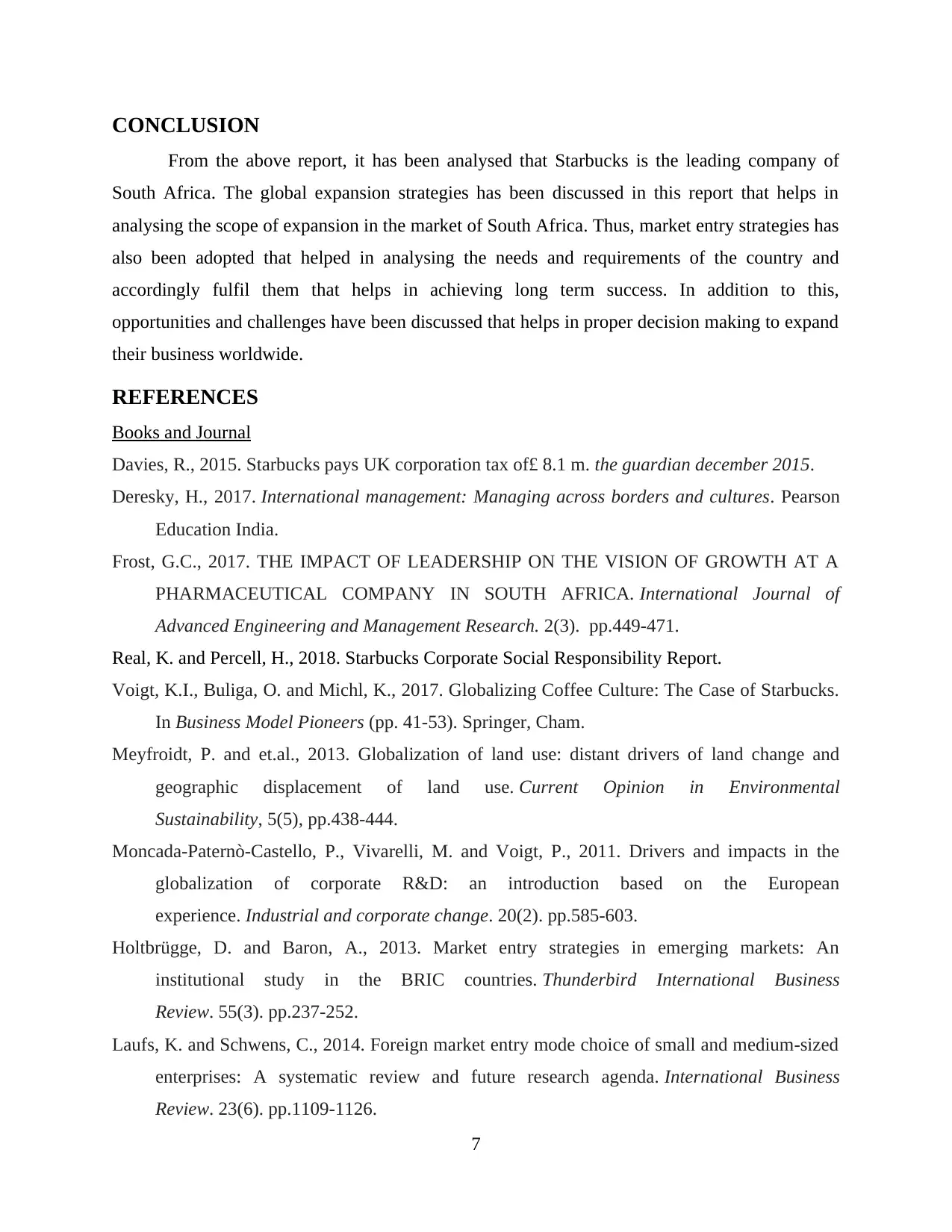
CONCLUSION
From the above report, it has been analysed that Starbucks is the leading company of
South Africa. The global expansion strategies has been discussed in this report that helps in
analysing the scope of expansion in the market of South Africa. Thus, market entry strategies has
also been adopted that helped in analysing the needs and requirements of the country and
accordingly fulfil them that helps in achieving long term success. In addition to this,
opportunities and challenges have been discussed that helps in proper decision making to expand
their business worldwide.
REFERENCES
Books and Journal
Davies, R., 2015. Starbucks pays UK corporation tax of£ 8.1 m. the guardian december 2015.
Deresky, H., 2017. International management: Managing across borders and cultures. Pearson
Education India.
Frost, G.C., 2017. THE IMPACT OF LEADERSHIP ON THE VISION OF GROWTH AT A
PHARMACEUTICAL COMPANY IN SOUTH AFRICA. International Journal of
Advanced Engineering and Management Research. 2(3). pp.449-471.
Real, K. and Percell, H., 2018. Starbucks Corporate Social Responsibility Report.
Voigt, K.I., Buliga, O. and Michl, K., 2017. Globalizing Coffee Culture: The Case of Starbucks.
In Business Model Pioneers (pp. 41-53). Springer, Cham.
Meyfroidt, P. and et.al., 2013. Globalization of land use: distant drivers of land change and
geographic displacement of land use. Current Opinion in Environmental
Sustainability, 5(5), pp.438-444.
Moncada-Paternò-Castello, P., Vivarelli, M. and Voigt, P., 2011. Drivers and impacts in the
globalization of corporate R&D: an introduction based on the European
experience. Industrial and corporate change. 20(2). pp.585-603.
Holtbrügge, D. and Baron, A., 2013. Market entry strategies in emerging markets: An
institutional study in the BRIC countries. Thunderbird International Business
Review. 55(3). pp.237-252.
Laufs, K. and Schwens, C., 2014. Foreign market entry mode choice of small and medium-sized
enterprises: A systematic review and future research agenda. International Business
Review. 23(6). pp.1109-1126.
7
From the above report, it has been analysed that Starbucks is the leading company of
South Africa. The global expansion strategies has been discussed in this report that helps in
analysing the scope of expansion in the market of South Africa. Thus, market entry strategies has
also been adopted that helped in analysing the needs and requirements of the country and
accordingly fulfil them that helps in achieving long term success. In addition to this,
opportunities and challenges have been discussed that helps in proper decision making to expand
their business worldwide.
REFERENCES
Books and Journal
Davies, R., 2015. Starbucks pays UK corporation tax of£ 8.1 m. the guardian december 2015.
Deresky, H., 2017. International management: Managing across borders and cultures. Pearson
Education India.
Frost, G.C., 2017. THE IMPACT OF LEADERSHIP ON THE VISION OF GROWTH AT A
PHARMACEUTICAL COMPANY IN SOUTH AFRICA. International Journal of
Advanced Engineering and Management Research. 2(3). pp.449-471.
Real, K. and Percell, H., 2018. Starbucks Corporate Social Responsibility Report.
Voigt, K.I., Buliga, O. and Michl, K., 2017. Globalizing Coffee Culture: The Case of Starbucks.
In Business Model Pioneers (pp. 41-53). Springer, Cham.
Meyfroidt, P. and et.al., 2013. Globalization of land use: distant drivers of land change and
geographic displacement of land use. Current Opinion in Environmental
Sustainability, 5(5), pp.438-444.
Moncada-Paternò-Castello, P., Vivarelli, M. and Voigt, P., 2011. Drivers and impacts in the
globalization of corporate R&D: an introduction based on the European
experience. Industrial and corporate change. 20(2). pp.585-603.
Holtbrügge, D. and Baron, A., 2013. Market entry strategies in emerging markets: An
institutional study in the BRIC countries. Thunderbird International Business
Review. 55(3). pp.237-252.
Laufs, K. and Schwens, C., 2014. Foreign market entry mode choice of small and medium-sized
enterprises: A systematic review and future research agenda. International Business
Review. 23(6). pp.1109-1126.
7
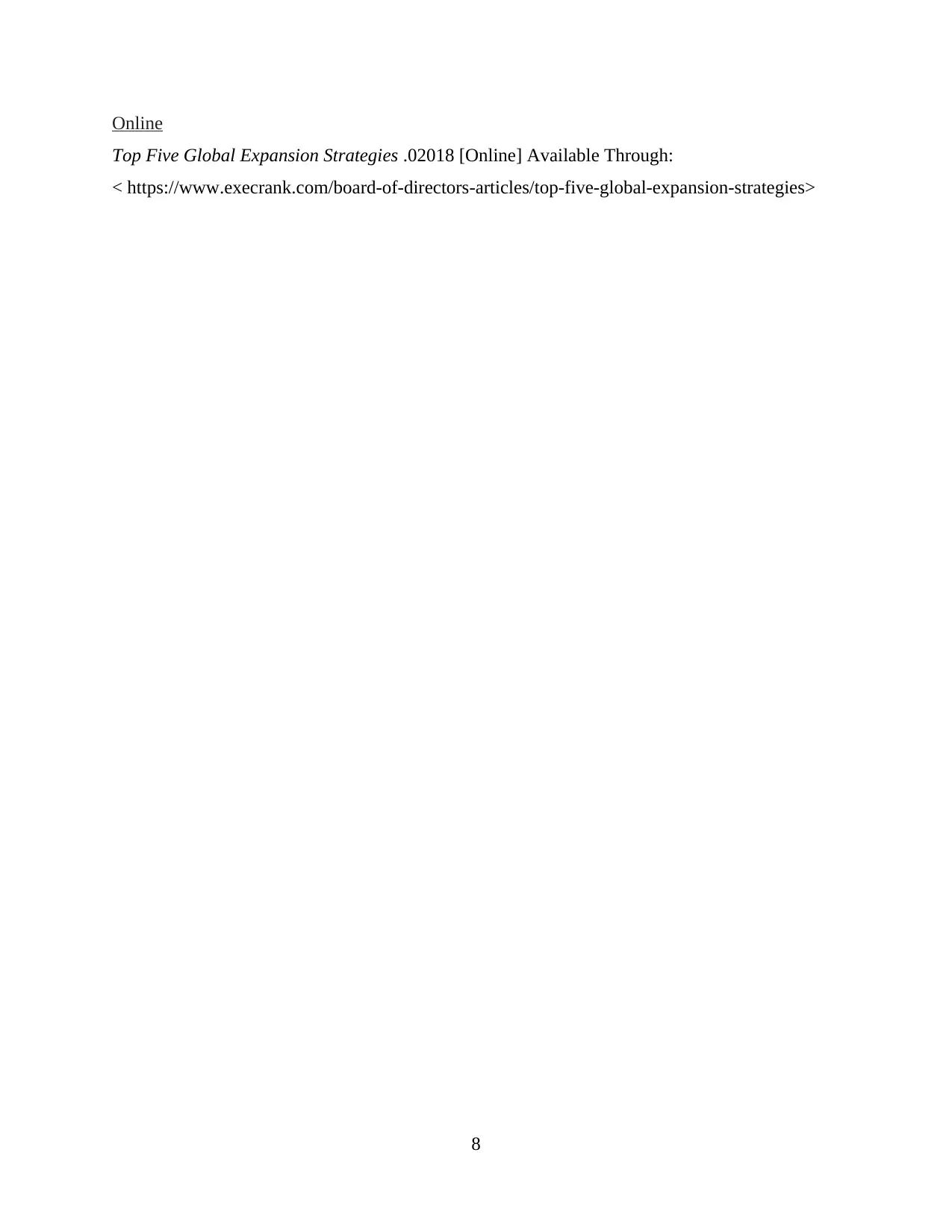
Online
Top Five Global Expansion Strategies .02018 [Online] Available Through:
< https://www.execrank.com/board-of-directors-articles/top-five-global-expansion-strategies>
8
Top Five Global Expansion Strategies .02018 [Online] Available Through:
< https://www.execrank.com/board-of-directors-articles/top-five-global-expansion-strategies>
8
⊘ This is a preview!⊘
Do you want full access?
Subscribe today to unlock all pages.

Trusted by 1+ million students worldwide
1 out of 9
Related Documents
Your All-in-One AI-Powered Toolkit for Academic Success.
+13062052269
info@desklib.com
Available 24*7 on WhatsApp / Email
![[object Object]](/_next/static/media/star-bottom.7253800d.svg)
Unlock your academic potential
Copyright © 2020–2025 A2Z Services. All Rights Reserved. Developed and managed by ZUCOL.




